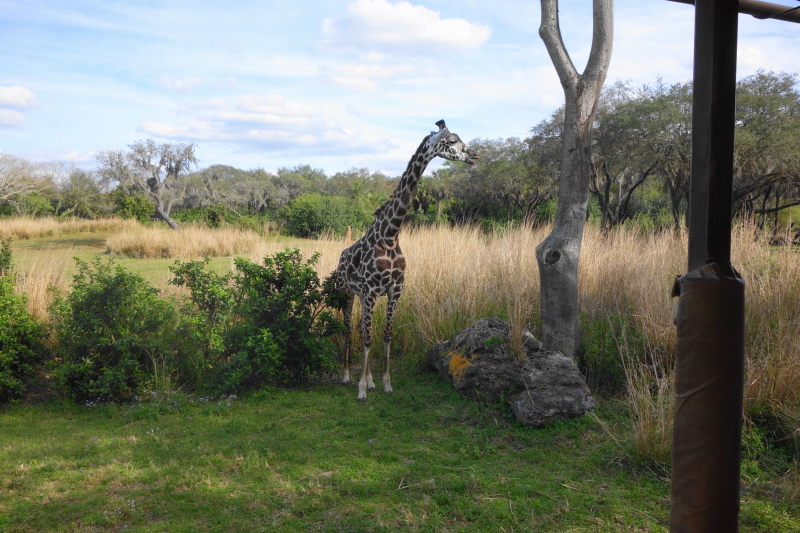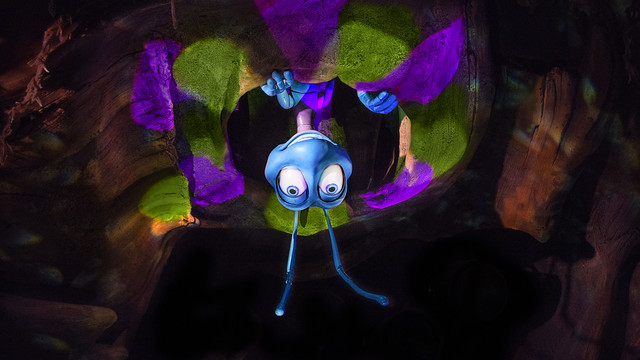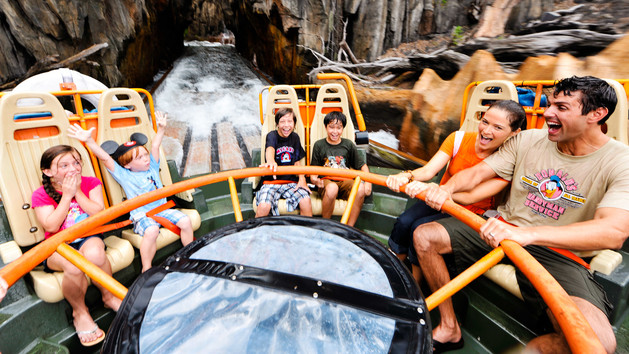Category — A Friday Visit with Jim Korkis
A Friday Visit with Jim Korkis: Kilimanjaro Safaris
Welcome back to Fridays with Jim Korkis! Jim, the dean of Disney historians and author of Jim’s Gems in The easy Guide, writes about Walt Disney World history every Friday on yourfirstvisit.net.
KILIMANJARO SAFARIS
By Jim Korkis

“Kilimanjaro Safaris is just one of many companies that offers photo excursions to tourists from around the world to The Harambe Wildlife Reserve. After three decades of operation, it has emerged as the premier provider of safe, affordable animal-viewing safaris in their fleet of ‘Tembo’ (Swahili for elephant) open-sided vehicles. In addition, the company hires and trains its safari drivers to offer a high level of information about the animals found on the Reserve.”
Just as current CEO Robert Iger’s game plan for Disney expansion has been to purchase popular franchises like Marvel and Lucasfilms, CEO Michael Eisner’s game plan for Walt Disney World was to create entertainment offerings that mimicked already popular offerings in the Central Florida area to keep money from Disney guests on Disney property instead of being spent at other venues.
Busch Gardens Tampa opened in 1959 as an African-themed experience that grew to be one of the largest zoological institutions with over 2,700 animals. In 1965, the park opened the twenty-nine acre Serengeti Plains, which allowed its African wildlife to roam freely.
The continued popularity of this amusement venue where tourists could get close to exotic wild animals for over thirty years encouraged Eisner to approve the building of Disney’s Animal Kingdom.
One of the centerpieces for DAK would be the Kilimanjaro Safari attraction, since guests would be eager to see animals differently than at a zoo. It is roughly 110 acres, making the attraction all by itself approximately the size of the Magic Kingdom Park.
In July 1990, Imagineering creative director Joe Rohde took a team to Kenya and Tanzania for two weeks. They took thousands of photographs and countless hours of video. In addition, they participated in many different safari tours to try to understand what a typical tourist might experience on their first time making such a visit.
Landscape architect Phil Schenkel and senior project engineer Dave Dahlke had to devise a recipe for concrete for the Kilimanjaro Safari’s two miles of rutted, potholed and washed out “dirt” road. They spent long hours matching the concrete color with the surrounding soil and then rolled tires through it as well as tossed stones, dirt and twigs to try to capture a seamless sense of reality not immediately recognized by the guests.
In addition, the roadway was designed to keep any water in the path separate from the water used by the animals. The potholes in the road with water actually have their own pumping and drainage system.
The Imagineers set up a test track in the parking lot at WDI in Glendale with similar potholes and ruts. However, when they took Disney Legend Marty Sklar for a practice spin, he spilled most of his coffee and his instant displeasure resulted in them going back to the drawing board to modify the design.
The ride still ended up pretty bumpy when it first opened with the park and some adjustments were made including additional padding on the backs of the seats.
Another challenge was selecting which animals would be exhibited. Some factors included if they would be active during the day, could be easily contained, got along well with the other selected animals, and how they would react to the tourists. Zoologist Rick Barongi provided helpful input to the Imagineers.
Originally, to emphasize the park’s commitment to conservation, the attraction included a story about the dangers of illegal poachers with signage, urgent radio alerts and more. The guests were involved in a frantic chase to rescue the kidnapped Big Red mother elephant, and her baby, Little Red.
Needless to say, that experience was upsetting to some, especially to younger guests, and the storyline with game warden Wilson Mutua is no longer part of the attraction.
Disney realized that guests were much more interested in just spotting animals and that the poacher storyline was considered confusing to them.
* * * * *
Thanks, Jim! And come back next Friday for even more from Jim Korkis!
In the meantime, check out his books, including Secret Stories of Walt Disney World: Things You Never You Never Knew, which reprints much material first written for this site, and The Vault of Walt: Volume 4, and his contributions to The easy Guide to Your First Walt Disney World Visit, all published by Theme Park Press.
Follow yourfirstvisit.net on Facebook or Google+ or Twitter or Pinterest!!
June 4, 2016 3 Comments
A Friday Visit with Jim Korkis: It’s Tough to Be a Bug
Welcome back to Fridays with Jim Korkis! Jim, the dean of Disney historians and author of Jim’s Gems in The easy Guide, writes about Walt Disney World history every Friday on yourfirstvisit.net.
IT’S TOUGH TO BE A BUG
By Jim Korkis
Many different proposals were considered for the area in the base of Disney’s Animal Kingdom Tree of Life. At one point the area would have been used by The Roots Restaurant, an upscale eatery. When it was decided the area should feature a show, a Wonders of Nature and a Lion King character show were possibilities that were seriously discussed.
It was CEO Michael Eisner who suggested during a particularly disappointing pitch meeting that bugs live in and under trees and that Pixar Animation was working on a new feature film about bugs called A Bug’s Life (1998). Imagineering consulted directly with Pixar, and while several characters from the film were used, new ones were created as well.
The decision to go with this concept was approved after construction had already begun on the Tree of Life. However, it still opened April 1998, roughly a full seven months before the release of the film that inspired it.
The queue line into the theater was designed to create the illusion that guests were shrinking to bug size as they navigated the increasingly narrow tunnels with everything else including the roots seeming to become enormous.
Currently the nine minute show being performed in the 430 seat auditorium is “It’s Tough To Be A Bug! Starring Flik and a cast of A Million Billion Bugs” that is similar to a vaudeville revue with individual acts.
This performance is the current show produced by the Tree of Life Repertory Theater. The pre-show waiting lobby is decorated with playbill posters from past performances whose titles are parodies of popular Broadway shows. Over the years, the followings posters were displayed:
My Fair Ladybug (My Fair Lady), Barefoot in the Bark (Neil Simon’s Barefoot in the Park), A Grass Menagerie (Tennessee Williams’ A Glass Menagerie), A Cockroach Line (A Chorus Line), Beauty and the Bees (“Bee Our Guest!”) (Disney’s Beauty and the Beast), Antie (Annie), Web Side Story (West Side Story), Little Shop of Hoppers (Little Shop of Horrors), A Stinkbug Named Desire (A Streetcar Named Desire) and The Dung and I (“featuring the hit song “Hello Dung Lovers”) (The King and I).
Some of those poster designs were done by Imagineers Nicole Armitage Doolittle (daughter of Frank Armitage, a Disney animation background artist and later Imagineer) and Milton Noji (who worked for almost five years at Disney on both interior and exterior signage). Unlike traditional theater posters, these posters are not decorated with snippets of critics’ reviews but interesting facts about the insect world.
The background music consists of a bug orchestra, sounding a lot like buzzing kazoos, playing iconic songs from these shows: One (Chorus Line), Beauty and the Beast (from Beauty and the Beast), Tomorrow (Annie), I Feel Pretty (West Side Story), Hello Young Lovers (The King and I), and Tonight (West Side Story but also includes the counterpoint Flight of the Bumblebee).
The theme song, “It’s Tough to be a Bug,” was written by George Wilkins with lyrics by Kevin Rafferty, who was the Show Writer for the project. The show’s score was composed and conducted by Bruce Broughton.
“My job was to impart the facts about ten quintillion bugs in only eight minutes,” stated Rafferty, who met with Ray Mendez an insect naturalist. “Ray said that, most important, they are responsible for our food, as pollinators, and they handle our waste. If it weren’t for bugs, we’d all be dead in six months. That impressed me. All the acts featured in the show are based on what actual bugs do. There really, truly are acid-spraying termites.”
* * * * *
Thanks, Jim! And come back next Friday for even more from Jim Korkis!
In the meantime, check out his books, including Secret Stories of Walt Disney World: Things You Never You Never Knew, which reprints much material first written for this site, and The Vault of Walt: Volume 4, and his contributions to The easy Guide to Your First Walt Disney World Visit, all published by Theme Park Press.
Follow yourfirstvisit.net on Facebook or Google+ or Twitter or Pinterest!!
May 28, 2016 1 Comment
A Friday Visit with Jim Korkis: Rock ‘N’ Roller Coaster at Disney’s Hollywood Studios
Welcome back to Fridays with Jim Korkis! Jim, the dean of Disney historians and author of Jim’s Gems in The easy Guide, writes about Walt Disney World history every Friday on yourfirstvisit.net.
ROCK ‘N’ ROLLER COASTER
By Jim Korkis
“When you’ve toured the world as much as we have, it’s a real thrill to find a new audience,” said lead singer of the band Aerosmith Steve Tyler in July 1999. “Coming up with a soundtrack for this Disney ride really brought the kid out in all of us and has given us the opportunity to play audio gymnastics with our music.”
Rock ‘N’ Roller Coaster with Aerosmith opened at Disney’s Hollywood Studios July 29, 1999. The attraction is a steel roller coaster created by the Vekoma Rides Manufacturing company that begins with powerful linear synchronous motors (LSM) that catapult the super stretch limo vehicle inspired by the design of a 1962 Cadillac from 0 to 57 miles per hour in just 2.8 seconds into a giant cobra roll and later a corkscrew inversion.
“The idea behind the ride is that guests just stepped into a recording studio where Aerosmith is rehearsing for an awards show. Suddenly, the group’s harried manager (actress Illeana Douglas) rushes in and announces that the band is running late. The members refuse to go to the show unless their loyal fans get to go as well.
“So, 24 guests at a time,” stated lead designer Jim Shull, “we pile you, the fans, into an enormous stretch limo – and you’re off.”
To justify having such an attraction in an area themed to 1940s Hollywood, the Imagineers came up with an interesting storyline that neither the guests nor the cast ever adopted and has been largely ignored and forgotten.
The queue line is themed to G-Force records, a fictional record company that was supposedly started in the 1930s. (The intercom calls for people are the names of Imagineers who worked on the attraction.) G-Force was known for attracting the best of the best in recording artists and became a growing force in the industry.
Things however took a turn for the worse on Halloween night 1939. While throwing a party at the neighboring Hollywood Tower Hotel (Twilight Zone Tower of Terror), a strange incident occurred where lightning struck the building and five hotel guests mysteriously disappeared. The hotel was closed and the public felt that somehow G-Force was responsible and their record sales plummeted.
Over time G-Force as a business began to re-emerge and rebuilt the existing studio, adding a giant forty-foot Stratocaster as its icon. Today at G-Force many of the top recording stars can be found using the state of the art facilities.
G-Force (with the “g” from “gravitational”) is a measurement of type of acceleration that causes weight like during a rocket launch. The guests on the attraction experience 4.5 Gs, more than an astronaut does on a space shuttle launch.
Aerosmith band members Steve Tyler and Joe Perry rode the attraction twelve times in a row and made several changes primarily to the recording studio pre-show to make it more realistic including the location of the guitars.
The vehicles have a built-in audio system that includes 125 speakers, 24 sub-woofers (one under each seat) and more than 32k watts of audio amplifier output.
Each vehicle features a different Aerosmith song or medley. Tracks are: “Nine Lives”; “Sweet Emotion”; a “Back in the Saddle”/”Dude Looks Like a Lady” medley; a “Love in an Elevator”/”Walk This Way” medley; and a “Young Lust”/”F.I.N.E.”/”Love in an Elevator” medley. Tyler and Perry were involved in the re-recording of the songs including changing the lyrics so that it is now “Love in a Roller Coaster”.
Aerosmith was chosen for the attraction because they had supplied two songs (“I Don’t Want to Miss a Thing” and “What Kind of Love Are You On”) for the soundtrack album of the 1998 Touchstone Pictures film Armageddon so they were already connected with Disney. It was rumored that Disney first approached the Rolling Stones, but logistic and financial issues like paying for the rights to their songs derailed that deal.
* * * * *
Thanks, Jim! And come back next Friday for even more from Jim Korkis!
In the meantime, check out his books, including Secret Stories of Walt Disney World: Things You Never You Never Knew, which reprints much material first written for this site, and The Vault of Walt: Volume 4, and his contributions to The easy Guide to Your First Walt Disney World Visit, all published by Theme Park Press.
Follow yourfirstvisit.net on Facebook or Google+ or Twitter or Pinterest!!
May 20, 2016 No Comments
A Friday Visit with Jim Korkis: Kali River Rapids
Welcome back to Fridays with Jim Korkis! Jim, the dean of Disney historians and author of Jim’s Gems in The easy Guide, writes about Walt Disney World history every Friday on yourfirstvisit.net.
KALI RIVER RAPIDS
By Jim Korkis
The Asia area opened at Disney’s Animal Kingdom in 1999 and included the popular water ride Kali River Rapids.
Just as Walt Disney originally wanted live animals on the Jungle Cruise ride at Disneyland, Imagineers initially developed an attraction called Tiger Rapids Run for DAK. The attraction would be a water safari on large raft-like vehicles giving guests a different view of the tiger habitat as well as encounters with other animals before finishing by shooting the rapids and a drop that felt “like the bottom has dropped out of the river” according to project director Joe Rohde.
There are still examples of tigers in the final attraction including multiple references in the queue line as well as carved images on top of the wooden pagoda where guests board the rafts. Of course, the final animal stone sentinel at the top of the ninety foot lift at the beginning of the ride is a tiger at the entrance to Tiger Bay.
Even though it was planned as a much longer ride than the version that was finally built, Imagineers decided that because of the speed of the attraction, guests might only see animals for fleeting seconds and that the noise and movement from the guests and the vehicles might disturb the animals.
So the attraction was changed into a botanical expedition where guests could enjoy the scenic beauty of the forest and then be shocked at how it is being ravaged and burned by illegal logging just as Africa’s Kilimanjaro Safaris told the story of the dangers of poaching. Basically, the ride became an ecotourism experience with the sound of wildlife coming from hidden speakers.
All of this is explained in a voice-over during the queue line by the fictional owner:
“Hello, my name is Manisha Gurung. I am the founder and manager of Kali Rapids Expeditions. When you board one of our rafts, you can look forward to an exciting, safe and very wet trip down a stretch of beautiful river. My team and I believe that our river rides are more than just an exciting adventure. We believe they help spread a message to visitors about preserving wild places. Like our forest.
“All around Anandapur, logging companies in search of tropical hardwood have bitten deep into the jungle. When this happens, the traditional life of the village and forest is destroyed forever. I created this river rafting experience to demonstrate that there are nondestructive ways to bring revenue to the village because the more people like you care, the better chance our jungle has of surviving. Thanks for choosing Kali Rapids Expeditions. We hope your journey will show you a world that is truly worth saving.”
Guring and her family live in a house elevated on stilts near the entrance of the attraction. Since Guring is busy elsewhere, she fails to hear that the logging has gotten too close to the river so is not there to stop guests from being dispatched.
This ride was manufactured by Intamin (INTernational AMusement Installations), a Swiss company noted for thrill rides and roller coasters. It built the very first “river rapids ride” Thunder River for AstroWorld in 1980. The company was also responsible for Grizzly River Run at Disney’s California Adventure in 2001.
Each circular raft with colorful individual names like Sherpa Surfer, Kali Bumper Car, and Manaslu Slammer seat twelve people around the perimeter as geysers, waterfalls, statues of water carriers and squirting elephants soak the guests.
The bobbing up and down and spinning journey goes down the Chakranadi meaning the “river that flows in a circle” in Sanskrit which is why the rafts return to the same place they disembarked. The name Kali refers to the Hindu Goddess of destruction referencing the smoldering charred tree trunks that originally featured fire effects.
Be warned that no matter what precautions you take, you will get wet but you MIGHT get soaked depending upon the twists and turns of fate.
* * * * *
Thanks, Jim! And come back next Friday for even more from Jim Korkis!
In the meantime, check out his books, including Secret Stories of Walt Disney World: Things You Never You Never Knew, which reprints much material first written for this site, and The Vault of Walt: Volume 4, and his contributions to The easy Guide to Your First Walt Disney World Visit, all published by Theme Park Press.
Follow yourfirstvisit.net on Facebook or Google+ or Twitter or Pinterest!!
May 13, 2016 No Comments
A Friday Visit with Jim Korkis: Disneyana
Welcome back to Fridays with Jim Korkis! Jim, the dean of Disney historians and author of Jim’s Gems in The easy Guide, writes about Walt Disney World history every Friday on yourfirstvisit.net.
THE FIRST DISNEYANA AT WALT DISNEY WORLD
By Jim Korkis
Two west coast Disney fan organizations, the Mouse Club and the National Fantasy Fan Club (now called the Disneyana Fan Club) held three day Disney conventions in Anaheim, California for many years beginning in 1982. Several hundred fans from around the country attended.
The popularity (and the financial rewards) of those conventions did not go unnoticed by the Disney Company. In September 24-27, 1992, Disney held its first Disneyana convention at Walt Disney World’s Contemporary Resort in Orlando.
“Welcome to our First ‘Official’ Disneyana Convention. Now, we know this is not the ‘first’ Disneyana Convention, but as Walt Disney once said, ‘There is no new idea in the world we live in…What you do is take a good one and improve on it’. So, we try to do that,” smiled Chairman of Walt Disney Attractions Dick Nunis in his welcoming speech. Later, in a special presentation, he reminisced about his career using audio and video clips of Walt Disney as well as the building of Walt Disney World.
The Disneyana convention was a major production with over 800 people and an elaborate attendee package (including a watch and a special pewter medallion sculpted by Marc Delle of the Disneyana Convention logo) as well as limited edition merchandise for sale that quickly sold out early.
Thursday evening was an Ice Cream Social at the Contemporary with original Mouseketeers Bobby Burgess, Sharon Baird and Sherri Albertoni autographing photographs at a façade of the Mouseketeer Clubhouse.
Friday had Dick Nunis (Chairman of Walt Disney Attractions) driving up with Mickey Mouse in the LiMOUSEine. Guests attended the official opening ceremony in the Fantasia Ballroom. Jack Wagner, the voice of Disney, was the emcee, reminding guests there was no photography or videotaping because “this special performance is for your eyes only”.
The speakers included landscaper Bill Evans, Max Howard (Director of Disney Feature Animation Florida), Bo Boyd (President of Disney Consumer Products) and Ester Ewert of Disney Art Editions among others.
The afternoon had a Limited Edition Sale and Artist Signing, a Disneyana Fair selling signs and props, a Disney Business Group Presentation (with displays by everyone from The Disney Channel to Disney Vacation Club to Disney Classics Collection), and a Disneyana trade show with independent dealers. The day finished with a Disneyana auction where an original individual Dumbo ride vehicle from Disneyland sold for $16,000.
On Saturday, Dave Smith and Robert Tieman were delivered to the convention in an armored truck for their presentation of thirty treasures of the Walt Disney Archives. In my opinion, both Dave and Robert should have counted as part of those treasures.
Imagineer Tony Baxter talked about Euro Disneyland and Admiral Joe Fowler enthralled the crowd even though he was in his 90s. That afternoon, the general public was allowed to join the conventioneers at various fairs and trade shows to spend their money. However, only the conventioneers got to attend that night’s banquet that finished with The Kids of the Kingdom performing “The Best of Disney.”
The 1993 convention was held in Anaheim, California. The Disneyana conventions hosted by Disney ended in 2003 and there is still speculation about the reasons for its demise. One Disney leader pointed out that while the convention made a healthy profit, it did not make an “obscene profit,” meaning that the time, labor, and resources could be re-allocated to something like pins and generate more income with less effort for the Disney Company.
Today the D23 Expo event begun in September 2009 has taken the place of these popular conventions.
* * * * *
Thanks, Jim! My bud Steve Bell (of Military Disney Tips) and I are thinking about attending the Dayton, Ohio Disneyana!
And come back next Friday for even more from Jim Korkis!
In the meantime, check out his books, including Secret Stories of Walt Disney World: Things You Never You Never Knew, which reprints much material first written for this site, and The Vault of Walt: Volume 4, and his contributions to The easy Guide to Your First Walt Disney World Visit, all published by Theme Park Press.
Follow yourfirstvisit.net on Facebook or Google+ or Twitter or Pinterest!!
May 6, 2016 No Comments
A Friday Visit with Jim Korkis: First Families at Disney World
Welcome back to Fridays with Jim Korkis! Jim, the dean of Disney historians and author of Jim’s Gems in The easy Guide, writes about Walt Disney World history every Friday on yourfirstvisit.net.
FIRST FAMILIES OF WALT DISNEY WORLD
By Jim Korkis
A tradition started at Disneyland on July 18, 1955 was to pick a “First Family” to be honored as the first official guests to enter a Disney theme park and to reward them with lifetime passes.
That same tradition continued at Walt Disney World when the Magic Kingdom opened on October 1, 1971.
The lucky sandy-haired father was William “Bill” Windsor Jr. from nearby Lakeland, Florida, who was accompanied by his pretty blue-eyed wife, Marty, and their sons Jay, who was 3 years old, and Lee, who was nearly 19 months old. It turned out they had arrived so early that the entire family had slept in their car overnight at the nearest roadside rest area in order to be among the first into the parking lot.
For the opening of Epcot on October 1, 1982, Richard Cason, his wife Paula, and their four children (Jennifer, 16; Chris, 15; Ricky, 14; and Jody, 13) were the first family. They were from Winter Park and got up at 4:30 a.m. to arrive at the park at six a.m. only to find the gates wouldn’t open to the parking lot until seven a.m.
Cason said he “drove around the loop” before finally making it into the parking lot. “I just told the kids to get out and run for the gate,” he told reporters at the Opening Ceremonies. They received a silver pass from Chairman and CEO of Walt Disney Productions, Card Walker.
Unfortunately, due to limited space, only the first family, Walker, the press and a handful of invited guests were allowed inside the gates to witness the opening ceremony. All the other guests that morning were kept outside and only saw the festivities on that evening’s newscasts.
For Disney MGM Studios that opened on May 1, 1989 (now Disney’s Hollywood Studios), the official “first family” was Allan and Mary Guiterrz (both 37) and their teen daughters Gina (16), Dawn (14) and Mary’s father Marshall Busser (61) from York, Pennsylvania. They had waited six hours to be the first ones.
Allan was a carpenter and Mary a postal worker and part-time belly dancer. They were greeted by Michael Eisner and Bob Hope who escorted them down Hollywood Boulevard. They commented that they were spending so much time with interviews that they worried they might not have time to see the park before they had to leave.
For the opening of Disney’s Animal Kingdom on April 22, 1998, by five a.m., 350 cars were waiting in the parking plaza. The park was scheduled to open at seven a.m. but there was such a crush of guests that Disney opened an hour earlier after a short ceremony that featured the song Circle of Life from the movie The Lion King (1994) and then had to close the park again seventy-five minutes later.
The first guests through the gate were Brenda Herr of St. Petersburg, Florida, her husband, Damon Chepren and their twenty-two month old son, Devon, who all napped for only two hours the night before cramped in a Mazda 626, to ensure a spot at the front.
“She was determined, and she let me know darn well we were going to make it happen,” Chepren said. “When we were waiting in the car, she looked me in the eyes and said, `You will run’.”
DAK also paid tribute to the first “Honorary First Family”, Michael Werikhe and his daughters, Acacia, 9, and Kora, 7, in a ceremony at the park’s Conservation Station. Werikhe was known throughout the world as “Rhino Man,” for his one-man crusade to boost public awareness of the plight of the black rhinoceros.
Roy E. Disney presented Werikhe with a giant “Key of Life,” in the shape of The Tree of Life, the park’s massive icon. In addition, Walt Disney World made a contribution in support of Werikhe’s conservation work.
* * * * *
Thanks, Jim! And come back next Friday for even more from Jim Korkis!
In the meantime, check out his books, including Secret Stories of Walt Disney World: Things You Never You Never Knew, which reprints much material first written for this site, and The Vault of Walt: Volume 4, and his contributions to The easy Guide to Your First Walt Disney World Visit, all published by Theme Park Press.
Follow yourfirstvisit.net on Facebook or Google+ or Twitter or Pinterest!!
April 29, 2016 No Comments





